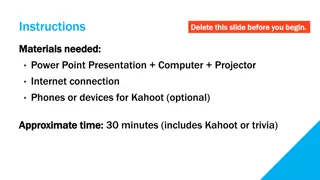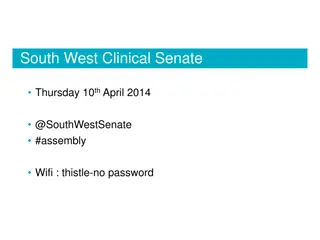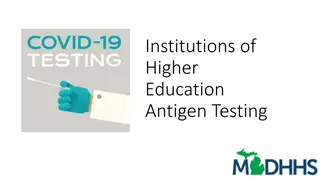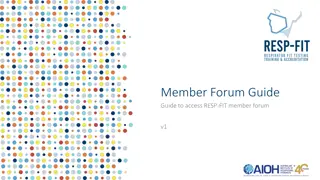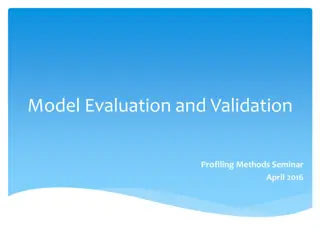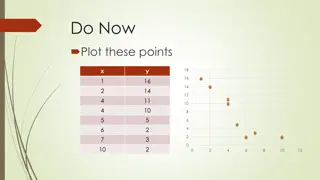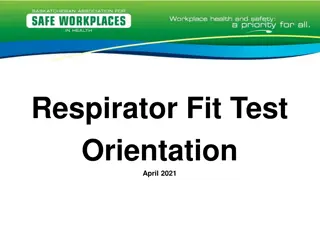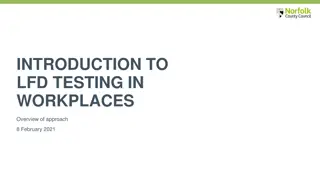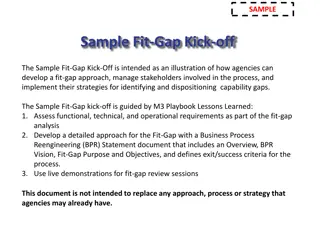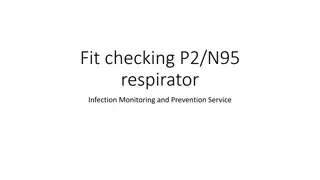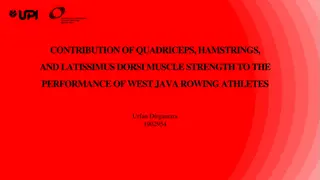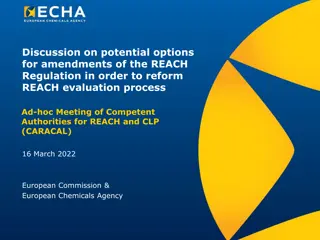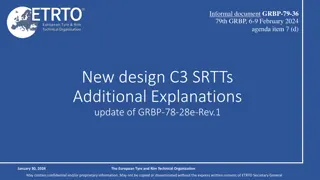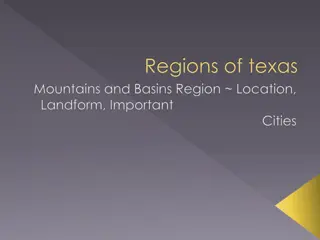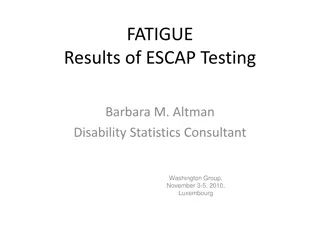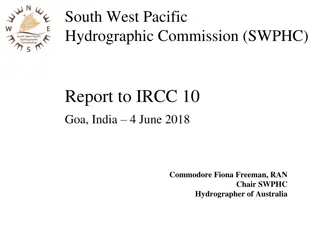FIT Testing Update in South West Region - Evaluation and Results Analysis
FIT testing was implemented in primary care practices across the South West region in 2018, focusing on symptomatic patients classified as low risk for colorectal cancer. Initial data evaluation revealed a positive predictive value (PPV) of 6.2%, exceeding NICE referral thresholds. SWAG results highlighted higher positivity rates compared to the Peninsula, highlighting variations in FIT uptake and testing trends across different localities within the region.
Download Presentation

Please find below an Image/Link to download the presentation.
The content on the website is provided AS IS for your information and personal use only. It may not be sold, licensed, or shared on other websites without obtaining consent from the author. Download presentation by click this link. If you encounter any issues during the download, it is possible that the publisher has removed the file from their server.
E N D
Presentation Transcript
FIT Testing update Patricia McLarnon
oduction oduction Introduction Introduction FIT testing was implemented in primary care across the South West region 2018 - 600 practices FIT was introduced for symptomatic patients who were classed as low risk, but not no risk of having colorectal cancer. These are patients who have unexplained symptoms, but did not previously meet the criteria for a suspected cancer referral pathway (amounting to a risk of cancer less than 3%). The first South West evaluation of the data showed, the test has a positive predictive value PPV of 6.2%. This suggests that the risk of cancer in the +ve FIT group is 6.2% -which is more than double the NICE threshold of 3% for a 2ww referral (in NICE NG12).
FIT FIT- - Results in SWAG Results in SWAG Number of cancers detected to date (June 2018 to March 2019) 43 Number of Positive tests (June 2018 to March 2019) Tests received (June 2018 to March 2019) No of cancers detected that are stage 1 or 2 Positive Rate (average) Locality SWAG 17% 3761 620 24** *Due to waiting times, not all data is available. Incomplete data set from Swindon and no results from North Bristol however, even with incomplete data PPV is still 7% **Not all have staging yet (Glos 7 and Bath may have a few more) Interestingly Gloucester (and North Devon for Peninsula) are identifying a high number of stage 1 more so that other trusts. We might need to explore this further.
Difference in positivity rates between SWAG and Peninsula The positivity rate in SWAG is consistently higher than in the Peninsula. The reasons for this are not yet known. Region 2018 2019 Total July Aug Aug Sept Sept Oct Oct-Nov Nov-Dec Dec-Jan Jan-Feb Feb-Mar Mar-April April-May Samples received SWAG 357 375 454 470 509 595 517 766 572 484 5099 Positive 51 58 85 75 91 87 89 141 89 84 17% 850 % positive 16% 15% 19% 16% 18% 15% 17% 18% 15% 17% Samples received Peninsula 375 325 378 366 374 373 508 596 508 318 4121 Positive 36 38 42 51 56 58 67 88 67 48 15% 551 % positive 10% 12% 11% 14% 15% 15% 13% 15% 13% 13%
FIT uptake in SWAG- Uptake of the test is variable across the region CRUK Facilitators % of practices who have sent <10 FIT referrals % of practices who have sent >10 FIT referrals CCG % of practices NOT using FIT BNSSG 2% (2) 29% (24) 69% (58) BaNES 0% (0) 57% (13) 43% (10) Gloucestershire 6% (5) 30% (24) 64% (51) Somerset 22% (15) 57% (38) 21% (14) Wiltshire 6% (3) 31% (15) 63% (30)
Use of FIT testing and Electronic reporting Locality Number of GP practices 23 No samples sent 0 % no samples sent 0% Electronic reporting 16 % electronic reporting 70% % of those using service 70% BANES Bristol 42 1 2% 42 100% 100% Gloucestershire 80 5 6% 5 6% 7% North Somerset 17 1 6% 15 88% 94% Somerset 67 14 21% 29 43% 55% South Gloucestershire 25 Wiltshire 0 3 0% 6% 25 36 100% 75% 100% 80% 48
GP Education & Experience of FIT GP Education & Experience of FIT To implement the test in primary care an education toolkit was produced including GP guidance (issued May 2018), a website: https://www.nbt.nhs.uk/severn-pathology/pathology-services/clinical-biochemistry/fit-testing and an online video: https://youtu.be/zb1o8ykvS6U This has been distributed to all GPs and practice staff through GP engagement events, via CCGS and additionally, with the kits. To gather detailed feedback from GPs, CR-UK conducted visits to GP Practices across the two alliances and an online survey was conducted the results of which are shown below 19 responses Emergent trends are being fed back into the programme as targeted improvements. For example safety netting is being improved by supporting the use of read codes for test requests. Questions I have issued a Faecal Immunochemical Test (FIT) to a patient? Yes 74% Agree 84% 17% No 26% Disagree 16% 5% The guidance I received about the test was sufficient The referral criteria for this test are clear to me I feel confident explaining and issuing this test 84% 16% I am satisfied that I have appropriate safety netting measures in place A negative FIT result will enable me to reassure patients when in the past a referral was needed. 63% 37% 84% 16%
Patient Information and Experience of FIT Patients are provided with information on how to use FIT in the pack they receive from their GP. A survey was included in the pack to ascertain user experience, the results are tabled below. Feedback has been very positive. Patient Survey Results (SWAG only) 178 Responses About the consultation with your GP Disagree 10% (15) 15% (24) 16% (28) Agree 90% (134) 85% (143) 84% (137) The GP explained the purpose of the test The GP clearly explained how to use the test The GP clearly explained what would happen when the results come back Using the FIT KIT Disagree 4% (7) 16% (19) 3% (5) Agree 96% (162) 84% (151) 97% (162) I understood the test instructions I found it easy to collect my sample I knew what to do with my sample afterwards Further patient information is under development including a video, and leaflet to support GP s advising patients.
FIT and Secondary Care FIT and Secondary Care One of the challenges in launching this test was that there was little supporting data to suggest how it might impact on secondary care. There was concern that it might increase demand on an already constrained service. However, the results of a local audit (Devon) suggested that patients in this cohort were being referred for routine investigations and that the new test should therefore reduce the number of patients undergoing an invasive test unnecessarily. Referral rates into secondary care have been carefully monitored and no notable impact has been seen in the data submissions from providers or raised by clinicians. An in depth audit is being carried out as part of the evaluation programme to understand what happens to FIT negative patients, and when FIT positive patients aren t referred as well as understand the diagnostic tests this cohort receive. We are now doing a follow up audit to understand what happened to the negative fit patients did they get referred anyway? How are they managed? Results from this will be available by September. Crucially through following feedback through SSG s, - none of the clinicians have experienced a hike in referral rates due to FIT - that they ve raised with us.
Future commissioning of the test Cancer Alliance funding of this test will conclude in March 2020, thereafter it will need to be commissioned by CCG s. As this is a new test, the project team are embarking on a robust programme of monitoring and evaluation to support commission decision making. This will conclude in January 2021 but an early insights paper will be available in time for the commissioning service planning rounds commencing in September 2019. The evaluation is being commissioned from the DISCOVERY Team, at Exeter University who are assessing the diagnostic performance of the test and health economics. To be robust, the evaluation must include 3500 patients (this is the volume of patients that received a FIT test between July & December 2018). To measure false negatives we need to assess whether any of those 3500 patients went on to develop Cancer within 12 months of their test. This is why the final (publishable) evaluation will not be available until January 2020.
Future commissioning of the test NICE published further guidance in July 2017 (DG30) which encourages the use of the test for any patient with abdominal symptoms who doesn t fit the NG12 2WW criteria. However, at the moment the Peninsula and SWAG Cancer Alliances are only offering the test to the cohort previously referred to in NG12. The Cancer Alliances will make recommendations on this in its commissioning support paper available for September 2019. Estimated running costs are anticipated to be less than 10 per test total revenue can be estimated from the figures per CCG above.


